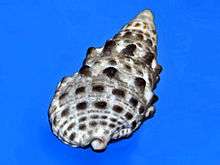Cerithium caeruleum
Cerithium caeruleum, the Cerith sand snail, is a species of sea snail, a marine gastropod mollusk in the family Cerithiidae.[1]
| Cerith sand snail | |
|---|---|
| Five views of a shell of Cerithium caeruleum | |
| Scientific classification | |
| Kingdom: | |
| Phylum: | |
| Class: | |
| (unranked): | |
| Superfamily: | |
| Family: | |
| Genus: | |
| Species: | C. caeruleum |
| Binomial name | |
| Cerithium caeruleum G.B. Sowerby II, 1855 | |
| Synonyms | |
| |
Distribution
This species is widespread in the tropical Indo-Pacific (Red Sea, Kenya, Madagascar, Mozambique, Tanzania and Western India).[1][2][3]

Shell of Cerithium caeruleum from Tanzania
Habitat
These sea snails live in rocky shores in the mid-eulittoral zone and deeper.[1]
Description
Shells of Cerithium caeruleum can reach a length of 20–40 millimetres (0.79–1.57 in).[2] These shells show a few rows of nodules and tiny beads on whorls. The external surface of the shell may be brown, greyish-white or greenish, with a white aperture.[1]
Bibliography
- Dautzenberg, Ph. (1929). Contribution à l'étude de la faune de Madagascar: Mollusca marina testacea. Faune des colonies françaises, III (fasc. 4). Société d'Editions géographiques, maritimes et coloniales: Paris. 321-636
- Hamlyn Guide to Shells of the World, p. 54
- Alain Robin - Encyclopedia of Marine Gastropods, p. 64/10
gollark: everyone is theyMWAHAHAHA
gollark: "Current target: Block #222 (shorthash 000000002e84, work 100000)", as I like to say.
gollark: Well, lyricly is currently somewhat insane.
gollark: Issues with what?
gollark: Maybe we should have some sort of emergency bot thing where people can vote to transfer administration to coltrans?
References
- "Cerithium caeruleum G. B. Sowerby II, 1855". World Register of Marine Species. Retrieved 16 December 2015.
- "Cerithium caeruleum". Gastropods.com. Retrieved 16 December 2015.
- "Cerithium caeruleum G.B. Sowerby II, 1855". Global Biodiversity Information Facility. Retrieved 16 December 2015.
This article is issued from Wikipedia. The text is licensed under Creative Commons - Attribution - Sharealike. Additional terms may apply for the media files.